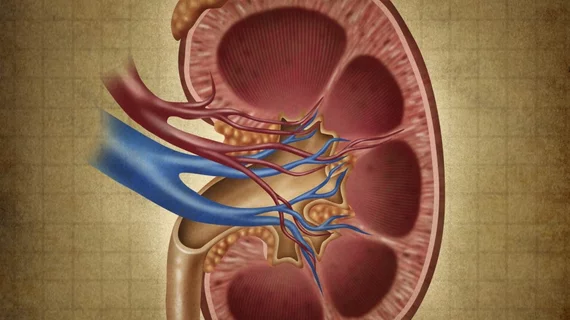How AI can help radiologists diagnose, treat kidney cancers
Machine learning models using radiomics can help radiologists classify renal cell carcinomas (RCCs), according to new findings published in the American Journal of Roentgenology.
“CT is gradually evolving into a useful imaging tool in renal mass differential diagnosis,” wrote Xue-Ying Sun, First Affiliated Hospital with Nanjing Medical University in China, and colleagues. “Several studies have reported that the use of enhancement threshold levels could help to distinguish RCC subtypes and discriminate RCC from benign oncocytoma with 77–84% accuracy. However, the differential diagnosis of renal mass-forming lesions is still difficult, and a variety of imaging findings have been described with different performance results reported.”
To see how machine learning can help improve such classification, the authors explored contrast-enhanced CT (CECT) scans showing 254 RCCs. A team of radiologists manually segmented lesions so that a full radiologic-radiomic analysis could be performed. A machine learning model was then trained to classify renal masses using a 10-fold cross-validation, and the models’ performance was compared to that of four veteran radiologists.
Overall, when differentiating clear cell RCCs (ccRCCs) from papillary RCCs (pRCCs) and chromophobe RCCs (chrRCCs), the four radiologists achieved a sensitivity that ranged from 73.7% to 96.8% and specificity that ranged from 48.4% to 71.9%. The team’s ML model had a sensitivity of 90% and specificity of 89.1% for that same scenario.
When differentiating ccRCCs from fat-poor angioleiomyolipomas and oncocytomas, the radiologists achieved a sensitivity that ranged from 73.7% to 96.8% and specificity that ranged from 52.8% to 88.9%. The ML model had a sensitivity of 86.3% and specificity of 83.3%.
Finally, when differentiating pRCCs and chrRCCs from fat-poor angioleiomyolipomas and oncocytomas, the radiologists achieved a sensitivity that ranged from 28.1% to 60.9% and a specificity that ranged from 75% to 88.9%. The ML model had a sensitivity of 73.4% and specificity of 91.7%.
“Our results show that routine expert-level radiologist interpretation of CT images had obviously large variances with relatively low accuracy in differentiation of benign and malignant solid renal masses, whereas the radiologic-radiomic ML approach provides an assessment of their ability to aid standardization of CECT interpretation,” the authors concluded. “Our radiologic-radiomic ML model, comprising quantitative radiomic features and a priori radiologic hallmarks that are different from a DL black-box algorithm, was able to significantly reduce the misclassification of renal mass lesions. Considering the interpretability of our radiologic-radiomic ML model, we believe that the radiologic-radiomic ML approach could be a potential adjunct to expert-level radiologist interpretation of CT images for improving interreader concordance and diagnostic performance in routine clinical assessment of renal masses.

